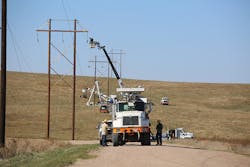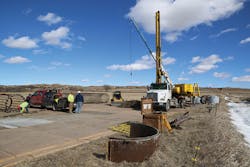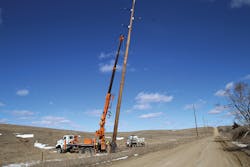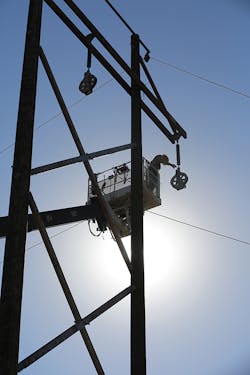NPPD Protects Land and Wildlife During Line Project
A new 115-kV transmission line now crosses over 40 miles in rural Nebraska, resolving voltage and loading issues in the area and connecting radial lines. The linemen constructed the line from the new Muddy Creek substation near an existing transmission line northeast of Broken Bow, Nebraska, to an existing substation near Ord.
By energizing the line in late March, NPPD met North American Electric Reliability Corporation (NERC) reliability standards. At the same time, the utility demonstrated the power of teamwork as crews from across its service territory came together to build the line.
Working as a Team
From September 2014 to August 2015, NPPD conducted a public involvement process that started with a 612-sq-mile study area. After the final route was announced in October 2015, the crews began construction in January 2017 and finished the job in March 2018.
Rather than outsourcing the work, NPPD decided to perform the work for the Muddy Creek transmission line project in-house. As such, the utility pulled together different members for its field team. For example, NPPD supplemented its main transmission line construction crew with workers from area transmission crews and distribution crews from the retail division. While it was a challenge getting everyone to work together when they weren’t accustomed to being on the same team, this approach paid off.
Transmission crews from York, North Platte, Norfolk, Kearney and Lincoln, Nebraska, worked more than 28,000 man-hours on the project, while distribution retail line crews from Norfolk, O’Neill, Chadron, Scottsbluff, Lexington, McCook, Ogallala, South Sioux City, York and Plattsmouth put in more than 15,000 man-hours. Also, substation construction colleagues devoted more than 1300 man-hours to the project.
During the project, NPPD cycled in field crew members from the different areas and slotted them in assigned time frames. These linemen from other parts of the service territory and different divisions were not required to work on the project, but they were asked to volunteer to augment the main transmission line crew. That way, NPPD could ensure the workers wanted to be on site and were committed to the success of the project.
Because the distribution crews were familiar with working on different voltages and structures, NPPD brought the different crews together to perform dry runs to assemble both single-pole and H-frame structures. That way, they could work out the details and understand the sequence of the assembly before working in the field.
In addition, NPPD conducted a separate meeting with the field crew prior to the start of construction to discuss the overall plan, the sequence of work and the schedule. At this meeting, NPPD was able to answer questions and familiarize everyone with the project.
Safeguarding Birds
When construction first began, the line crews installed a total of 526 structures, which included two types of wood structures along with 15 steel pole structures. In addition, the linemen installed fiber-optic shield wire that ran the length of the 115-kV line.
On about 10.5 miles of the line, NPPD also installed about 1760 bird flight diverters on the shield wire. NPPD installed the flight diverters to make the shield wire more visible to birds, helping to reduce the potential for avian collisions.
The company hired a contractor to install the devices on two different spots of the line — the west end close to a wind farm and a river valley. Using a helicopter, the contractor installed the diverters, which consisted of plastic rods wrapped in a helical format. A helicopter pilot would fly up next to the line, and a worker would lean over and install the diverters every 25 ft to 50 ft.
Because of the local avian population, the construction team had to follow federal and internal guidelines on the project. For example, during whooping crane migration periods, the linemen conducted daily surveys within a half mile of the work site to verify the absence of whooping cranes. If any whooping cranes were spotted within a half mile of the work area, work would have to shut down in that location until the whooping cranes departed. During the Muddy Creek project, however, the crews did not encounter any of these protected species.
Placing Mats
Because the construction project lasted more than a year, the linemen worked during some of the wettest times of the year. Rather than driving heavy equipment over muddy land following storms, however, NPPD focused on trying to minimize the impact to the land and reduce property damage on the 40-mile project.
For example, to prevent soil compaction and rutting, the utility moved equipment over special matting in low-lying areas. NPPD owns some wooden timber mats and used some of them on the Muddy Creek project, but it was looking for a better alternative. As such, NPPD rented composite mats, which were made of hard plastic and measured 4 inches thick by 8 ft wide by 14 ft long. While composite mats have been used within the industry for years, this was the first use of these mats by NPPD.
The interlocking mats can be purchased or rented. For this project, NPPD had the supplier install the mats. These mats were installed in two locations where concrete foundations for steel poles would be installed and they would be subject to the heavy weight of concrete trucks.
By using composite mats, NPPD was able to reduce the time required to set and remove the mats compared to the use of wooden mats. In addition, NPPD was able to significantly reduce the impact to the land, and as a result, the utility had less damage settlements than on past projects. Through the rental of composite matting, collaborating with landowners, working around weather conditions and making a concerted effort to minimize damages, NPPD’s construction crews were able to minimize the impact to landowners.
Minimizing Outages
NPPD tried not only to reduce the impact to the land, but also to minimize the number and duration of outages. For example, the new line crossed a few distribution lines that were left energized when it was possible to safely do so.
In one case, the linemen had to cross a distribution line with a tie line into the new Muddy Creek substation that tapped into an existing 115-kV radial line running into a wind farm. Because the wind farm was concerned about trying to reduce the outage time frame to minimize lost generation, NPPD realized it could shorten the outage to the radial line if it could bury a portion of the distribution line underground. To pay for this overhead-to-underground conversion, NPPD and the wind farm split the cost evenly. In turn, the linemen were able to shorten the outage to the radial line when installing the tie line.
Building for the Future
During the project, the linemen built the line mostly over pasture land and crop land, but it did skirt the edge of the community of Comstock, which has 135 residents. NPPD decided to route the line along the existing highway river crossing at Comstock to minimize any impact on the river.
The utility opted to situate its construction yard and trailer in the town of Comstock. That way, the linemen had one central location to work out of during the construction of the line.
After nearly 15 months, NPPD was able to energize the line. A month later, Mother Nature tested the new line with a blizzard in Custer and Valley counties that knocked down many of the local rural public power districts’ distribution lines. The Muddy Creek transmission line, however, held up through the heavy snow, and NPPD was able to use it as a backup. The line fulfilled its purpose and should be able to serve the area for many years in the future. ♦
Mike Hasenkamp is a senior project manager for the Nebraska Public Power District. He has been with the company for 40 years.
About the Author
Mike Hasenkamp
Mike Hasenkamp is a senior project manager for the Nebraska Public Power District. He has been with the company for 40 years.





